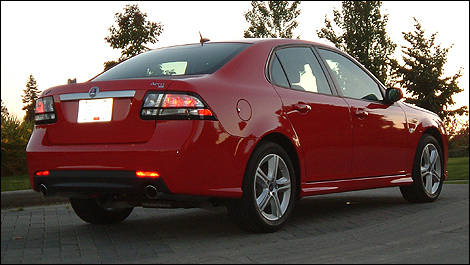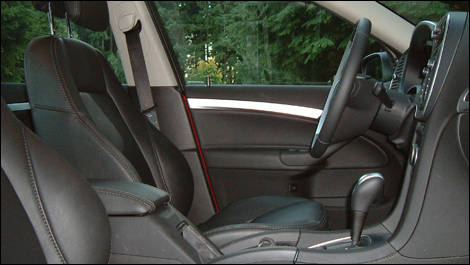XWD (short for Cross-Wheel-Drive, Saab's version of all-wheel-drive) is in my view the most significant technological advancement adopted by Saab in years. This sophisticated all-wheel-drive system is now available on the 9-3 sedan and Combi. The XWD option package added $2,340.00 to this week's tester however it also included a bump in horsepower, self-leveling rear shock absorbers and 17" x 7" alloy wheels shod in P225/50R17 all-season tires.
Discreetly updated exterior styling
Before delving into the mechanics of what makes this car extremely roadworthy and agile, let's have a quick gander at its new sheet metal and styling revisions. Like Volvo, Saab styling tends to evolve over time rather than abruptly, and the 9-3 is a good example of this progression. Seventy-percent of the car's sheet metal has been revised to improve aerodynamics and visual appeal but you'd barely know it.
Most apparent to the Saab-uninitiated would be the black taillight outlining and a more aggressive snout that includes a huge air intake below the traditional grille arrangement and fog-lights on display like expensive jewelry. The car is also sleeker than Saabs of yore, achieving an outstanding 0.28 co-efficient of drag.
Uniquely-Saab interior
Inside the four-door cabin things remain Saab'ish, which is to say quirkiness - such as a centre-console-mounted ignition switch - is retained. Also exclusive to Saab and a direct trickle-down from their aeronautics roots is the nightpanel feature, which extinguishes all but essential instrument panel lighting. This function removes extraneous lighting, allowing the driver's attention to focus on the darkness outside while minimizing distracting reflection and glare.
I'm a fan of the nightpanel and wonder why it isn't more deeply entrenched in the auto industry. When the nightpanel feature isn't activated, drivers will undoubtedly appreciate the clear, unimpeded view they have of the gauge cluster in the dramatically flat instrument panel, which is another Saab hallmark. Saab has applied a straightforward approach to its switchgear. Controls and buttons are easy to operate and logically located.
 |
| This is a uniquely satisfying sedan from a driver's perspective. |
Discreetly updated exterior styling
Before delving into the mechanics of what makes this car extremely roadworthy and agile, let's have a quick gander at its new sheet metal and styling revisions. Like Volvo, Saab styling tends to evolve over time rather than abruptly, and the 9-3 is a good example of this progression. Seventy-percent of the car's sheet metal has been revised to improve aerodynamics and visual appeal but you'd barely know it.
Most apparent to the Saab-uninitiated would be the black taillight outlining and a more aggressive snout that includes a huge air intake below the traditional grille arrangement and fog-lights on display like expensive jewelry. The car is also sleeker than Saabs of yore, achieving an outstanding 0.28 co-efficient of drag.
Uniquely-Saab interior
Inside the four-door cabin things remain Saab'ish, which is to say quirkiness - such as a centre-console-mounted ignition switch - is retained. Also exclusive to Saab and a direct trickle-down from their aeronautics roots is the nightpanel feature, which extinguishes all but essential instrument panel lighting. This function removes extraneous lighting, allowing the driver's attention to focus on the darkness outside while minimizing distracting reflection and glare.
I'm a fan of the nightpanel and wonder why it isn't more deeply entrenched in the auto industry. When the nightpanel feature isn't activated, drivers will undoubtedly appreciate the clear, unimpeded view they have of the gauge cluster in the dramatically flat instrument panel, which is another Saab hallmark. Saab has applied a straightforward approach to its switchgear. Controls and buttons are easy to operate and logically located.
 |
| The front seats in my tester were upholstered in soft leather. |




